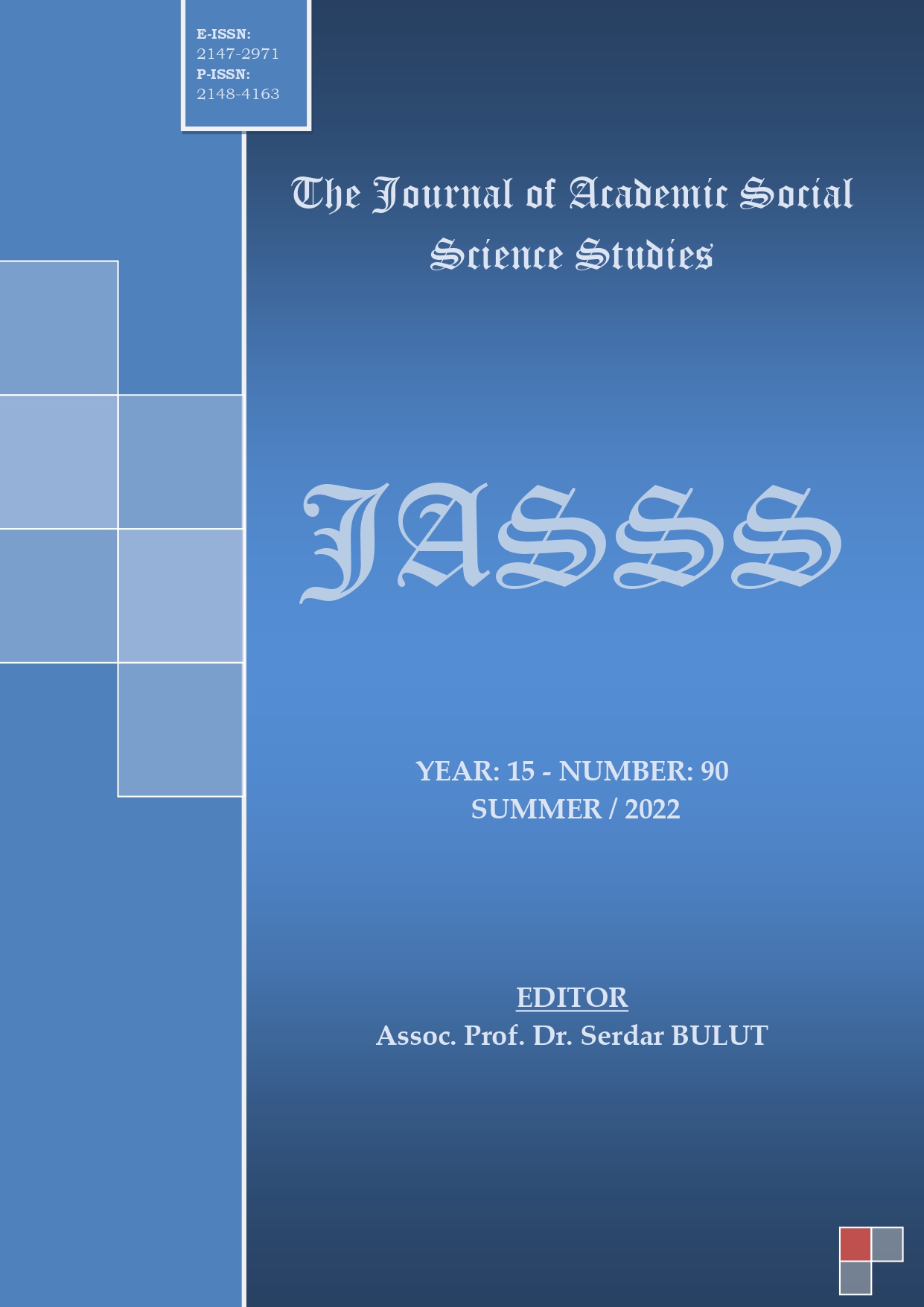CHARLOTTE PERKINS GILMAN’IN SARI DUVAR KAĞIDI ESERİNDE İMGELEME ARACILIĞIYLA FEMİNİST ÖYKÜNÜN RESMEDİLMESİ
Author :
Abstract
Bu makale, Charlotte Perkins Gilman'ın Sarı Duvar Kağıdı (1892) adlı kısa öyküsünde kullanılan kadın kahramanın psikolojisini feminist bir tablo gibi ortaya koyan imgelemeyi incelemektedir. Öyküde anlatıcı baş karakter, Jane, odası, duvar kağıdı, duvar kağıdının güneş ve ayın etkisiyle değişen renkleri, gözlemlenen desenlerin dönüşümü, dans eden şekiller, ev, çevre gibi çeşitli varlıkların berrak görüntülerini sunar. Duvar kağıdının sürekli bir hareket halindeki tasviri, odağı duvar kağıdına sabitlenen kahramanın değişen zihinsel ve fiziksel durumunu yansıtır. Duvar kağıdındaki akışkan desenler, kadın anlatıcının dengesiz zihnini, bastırılmış duygularını ve psikolojik yozlaşmasını yansıtır. Parmaklıklı bir odada duvar kağıdının yırtılması ve yeni doğmuş kadın imgesi, Panopticon gözetimi altında hapsedilmesinin zincirlerini kırmaya çalışan kadının özgürlük mücadelesini simgeliyor. Çalışma, özellikle feminist perspektiflerden çok yönlü zihniyetleri analiz ederek Gilman'ın Sarı Duvar Kağıdı'nda (1892) kadınların özgürleşmesini aydınlatmak için kullanılan imgelere odaklanmaktadır. Bu araştırmadaki metodoloji, kısa öyküyü Gilman'ın (1892) feminist bir tablosu olarak incelemeyi takip eder ve Francesca Woodman, Remedios Varo ve Salvador Dali'nin resimlerinde köleleştirilmemiş kadın figürlerine benzer bir anlam verir. Çalışma, hakim feminist söylemi kabul ederek, Gilman'ın Sarı Duvar Kağıdı'nda (1892) hayal gücünün ilahi gücü yardımıyla duvardaki desenleri önce okuyup sonra devrilmiş erkek otoritesi üzerinde kendi hikayesini yazan muzaffer bir kadının hikayesini resmettiği sonucuna varıyor.
Keywords
Abstract
This paper observes the imagery used in Charlotte Perkins Gilman’s short story The Yellow Wallpaper (1892) like a feminist painting revealing the psychology of the female protagonist. In the story, the narrator protagonist, Jane, provides lucid images of various entities such as her room, the wallpaper, and the changing colours of the wallpaper by the effect of the sun and the moon, the transformation of the observed patterns, dancing shapes, the house, the environment etc. The descriptions of the wallpaper in a constant movement reflect the changing mental and physical condition of the protagonist whose focus is fixed on the wallpaper. The fluid patterns on the wallpaper project the female narrator’s unstable mind, repressed emotions, and psychological degeneration. Tearing off the wallpaper in the barred room and the new-born female imagery symbolise the female struggle for freedom trying to break the chains of her imprisonment under the Panopticon surveillance. The study focuses on the imagery used to enlighten the female emancipation in Gilman’s The Yellow Wallpaper (1892) by analysing the multiplexed mindsets especially from feminist perspectives. The methodology in this research follows analysing the short story as a feminist painting by Gilman (1892) and it gives an analogous sense to the non-enslaved female figures in the paintings of Francesca Woodman, Remedios Varo and Salvador Dali. Acknowledging the prevailing feminist discourse, the study concludes that, by the help of the divine power of imagination, Gilman, in her The Yellow Wallpaper (1892), paints the story of a triumphant woman who first reads the patterns on the wall and writes her own story on the overthrown male authority.
Keywords
- Bak, J. S. (1994). Escaping the jaundiced eye: Foucauldian Panopticism in Charlotte Perkins Gilman’s “The Yellow Wallpaper”. Studies in Short Fiction 31(1), 39-46.
- Chavez, B. B. (2003). If these walls could talk: Female agency and structural inhabitants in Charlotte Perkins Gilman’s “The Yellow Wallpaper” and the paintings of Remedios Varo. Studies in Popular Culture, 26(2), 71-87.
- Davison, C. M. (2004). Haunted House/Haunted Heroine: Female Gothic Closets in “The Yellow Wallpaper”. Women’s Studies 33(1), 47–75.
- Edelstein, S. (2007). Charlotte Perkins Gilman and the yellow newspaper. Legacy, 24(1), 72–92.
- Foucault, M. (1979). Discipline and punish: The birth of the prison. Trans. Alan Sheridan. Vintage.
- Gilman, C. P. (2016). The Yellow Wallpaper. In J. Reidhead (Ed.), The Norton Anthology of American Literature Volume Two/C 9th ed. (pp. 844-855). Norton. (Original work published in 1892).
- Güngör, T. Ö. and Zeybek N. (2021) An ecofeminist reading of Charlotte Perkins Gilman’s “The Yellow Wallpaper”. Turkish Studies – Language, 16(2), 1189-1201.
- Hall, T. R. (1994). Charlotte Perkins Gilman’s “The Yellow Wallpaper”: A surrealistic portrayal of a woman’s arrested development. Viewpoints, 142(1), 1-13.
- Hume, B. A. (2002). Managing Madness in Gilman’s “The Yellow Wall-Paper”. Studies in American Fiction, 30(1), 3-20.
- Jamil, S. (2021). Imaginative power in “The Yellow Wallpaper”. ANQ: A Quarterly Journal of Short Articles, Notes and Reviews, 1-7.
- Jean, S. S. (2002). Hanging “The Yellow Wall-Paper”: Feminism and textual studies. Feminist Studies, 28(2), 397-415.
- Johnson, G. (1989). Gilman’s gothic allegory: Rage and redemption in “The Yellow Wallpaper”. Studies in Short Fiction, 26(4), 521-530.
- Liu, J. (2004). Francesca Woodman’s self-images: Transforming bodies in the space of femininity. Woman’s Art Journal, 25(1), 26-31.
- Lockwood, J. S. (2012). Charlotte Perkins Gilman’s colonial revival. Legacy, 29(1), 86-114.
- Notaro, A. (1999). Space and domesticity in “The Yellow Wallpaper” by Charlotte Perkins Gilman. Journal of American Studies of Turkey, 10(1), 59-68.
- Özyön, A. (2020). A journey of feminist rebellion through Charlotte Perkins Gilman’s short story The Yellow Wallpaper and her novel Herland. International Journal of Language Academy (IJLA), 8(5),115 - 124.
- Rao, K. V. R. (2006). The Yellow Wallpaper – a dynamic symbol: A study of Charlotte Perkins Gilman’s story. Poetcrit, 19(1), 38-44.
- Showalter, E. (1991) Sister’s choice: Tradition and change in American women’s writing. Clarendon Press.
- Shumaker, C. (1985). “Too Terribly Good to Be Printed”: Charlotte Gilman’s “The Yellow Wallpaper”. American Literature, 57(4), 588–99.
- Suess, B. A. (2003). The writing’s on the wall: Symbolic orders in “The Yellow Wallpaper”. Women’s Studies, 32(1), 79-97.
- Wilde, O. (1994). The picture of Dorian Gray. Dover.
- Wolter, J. (2009). “The Yellow Wall-Paper”: The ambivalence of changing discourses. American Studies, 54(2), 195-210.
